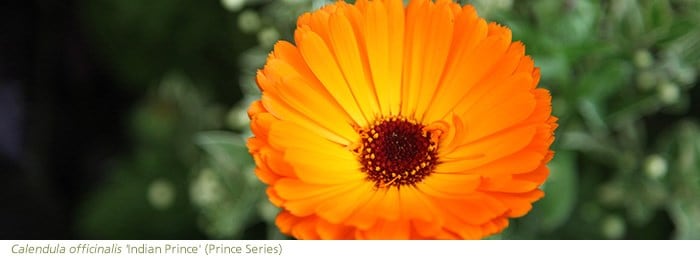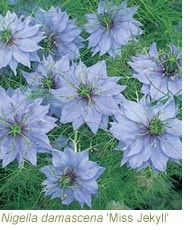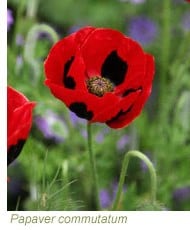Sowing tough hardy annual seeds
Tough Hardy Annuals
If you are wanting to have a go at growing seeds then the easiest of all are the annuals because they are programmed to germinate, flower and set seed within one year - therefore they pop up easily because there’s no time to waste. Most will provide nectar and pollen aplenty, but the easily accessible single-flowered forms are best as they’re more bee-friendly.
Hardy annuals are very easy as they are not affected by the frost and can and do survive over winter. To generalise they set copious amounts of seed and almost all self-seed when left to their own devices. As a result seedlings often pop up in autumn and they will overwinter unless the weather is extremely harsh. Hardy annuals tend to peak in midsummer, but can be kept going by regular deadheading up until late-August. Then it’s best to leave the plants to produce seeds, which can be collected and kept as long as the heads are harvested in dry weather.

Many hardy annuals are best sprinkled directly into well-prepared soil, as they develop tap roots early on. After sowing they will need covering up with sticks or wire to prevent cat activity. However the soil must be warm before you sow and, for best results, it’s better to wait until early May before doing your sprinkling. Sow too early and germination will be poor. This is very true for the green Bells of Ireland (Moluccella laevis) which is a Turkish native partial to warm sites. This must be sprinkled: it resents disturbance and cannot be pricked out.
Good ‘sprinklers’ include the orange daisy pot marigold (Calendula officinalis) and there’s a fine orange form called ‘Indian Prince’ which has a mahogany eye that picks up duskier colours. Calendulas have edible petals and these can add extra sparkle to salads, or you can add them to cakes. Their orange flowers also attract helpful hoverflies and these pollinators lay their eggs, singly, close to colonies of aphids. These look like tiny ivory rugby balls. Once the eggs hatch the insectivorous larvae devour lots of garden pests, so orange hoverfly magnets are an excellent addition to the vegetable patch. The large crescent-shaped seeds of pot marigolds are easy to collect, but it’s best to deadhead early on to keep the supply of flowers coming. Add some fiddleneck (Phacelia tanacetifolia) to your ‘sprinkle’ mixture, a lavender-blue bee pleaser, plus some blue borage as a contrast. Phacelia is alive with bees in the evening and it can be dug in as a green manure.
 Nigella damascena, more commonly known as Love-in-a-mist, has feathery foliage which is very delicate and wispy - just like moorland mist. The fleeting flowers come in many shades of blue and white including the sky-blue ‘Miss Jekyll’, the white ‘Albion Green Pod’ and the blue and white ‘Delft Blue’. Seed heads follow and are every bit as attractive as the flowers, so deadheading is not advisable. The plump green pods, crowned with seven upright green ‘tendrils’, sometimes have attractive maroon shading. They make a classic dried flower and each cavity is stuffed with plenty of black seeds that ensure next year’s supply.
Nigella damascena, more commonly known as Love-in-a-mist, has feathery foliage which is very delicate and wispy - just like moorland mist. The fleeting flowers come in many shades of blue and white including the sky-blue ‘Miss Jekyll’, the white ‘Albion Green Pod’ and the blue and white ‘Delft Blue’. Seed heads follow and are every bit as attractive as the flowers, so deadheading is not advisable. The plump green pods, crowned with seven upright green ‘tendrils’, sometimes have attractive maroon shading. They make a classic dried flower and each cavity is stuffed with plenty of black seeds that ensure next year’s supply.
 Poppies are also best sprinkled and, although their flowers are ephemeral, they provide a delicate tissue-paper presence in the summer garden. The flowers are rarely without a hoverfly because poppies produce copious amounts of pollen, but no nectar. Pollen is an essential protein needed for breeding. The seed heads are attractive too, green pepperpots studded in black, but some taller poppies (such as Papaver somniferum) produce vast numbers of seeds. Most seed heads should be removed before they discharge their load. More diminutive poppies need to have their seedpods left alone however and some should be collected and stored and some left to self-seed. The best plants come from autumn-germinating seedlings. The red and black ladybird poppy (P. commutatum) and the divine 'Fairy Wings', a selected form of our own field poppy, are both excellent. When sowing poppy seeds, lie them on the top of the soil surface because light induces germination.
Poppies are also best sprinkled and, although their flowers are ephemeral, they provide a delicate tissue-paper presence in the summer garden. The flowers are rarely without a hoverfly because poppies produce copious amounts of pollen, but no nectar. Pollen is an essential protein needed for breeding. The seed heads are attractive too, green pepperpots studded in black, but some taller poppies (such as Papaver somniferum) produce vast numbers of seeds. Most seed heads should be removed before they discharge their load. More diminutive poppies need to have their seedpods left alone however and some should be collected and stored and some left to self-seed. The best plants come from autumn-germinating seedlings. The red and black ladybird poppy (P. commutatum) and the divine 'Fairy Wings', a selected form of our own field poppy, are both excellent. When sowing poppy seeds, lie them on the top of the soil surface because light induces germination.






